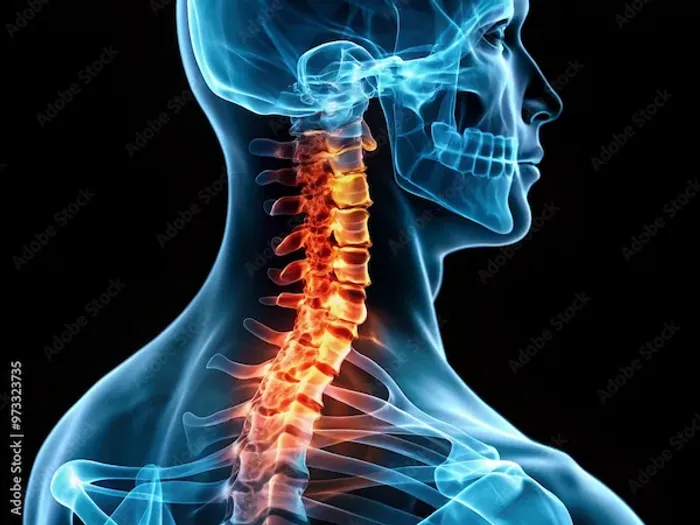Understanding Thoracic Spondylosis Causes and Symptoms
Gain a comprehensive understanding of Thoracic Spondylosis, including its common causes like aging, poor posture, and injury, along with key symptoms such as back pain, stiffness, and nerve compression. Learn what to look for and when to seek help.


Thoracic spondylosis is a condition that affects the middle part of your spine, known as the thoracic spine. While it may sound complicated, it simply refers to age-related wear and tear of the bones, discs, and ligaments in this area. If you or a loved one has been diagnosed with thoracic spondylosis, don’t worry—it’s a common condition, especially as we age. This article will help you understand its causes, symptoms, and ways to manage it effectively.
What Is Thoracic Spondylosis?
Your spine is made up of small bones called vertebrae, cushioned by soft discs that act as shock absorbers. Over time, these discs can wear down, and the bones may develop small growths called bone spurs. When this happens in the thoracic spine (the area between your neck and lower back), it’s called thoracic spondylosis.
Unlike cervical (neck) or lumbar (lower back) spondylosis, thoracic spondylosis is less common because this part of the spine is more stable and less prone to movement-related stress. However, when it does occur, it can cause discomfort and stiffness.
Common Causes of Thoracic Spondylosis
Several factors contribute to thoracic spondylosis, including:
Aging – The most common cause, as spinal discs naturally lose moisture and flexibility over time.
Poor Posture – Slouching or sitting incorrectly for long periods can put extra pressure on the thoracic spine.
Repetitive Strain – Jobs or activities that involve heavy lifting or twisting can accelerate wear and tear.
Previous Injuries – Trauma or fractures in the spine may lead to early degeneration.
Genetics – Some people are more prone to spinal degeneration due to family history.
Lack of Exercise – Weak back muscles can increase stress on the spine.
Consult Top Oncologist For personalised Tips
Symptoms of Thoracic Spondylosis
Not everyone with thoracic spondylosis experiences symptoms, but when they do occur, they may include:
Stiffness and Pain – A dull, aching pain in the middle back that worsens with movement.
Reduced Flexibility – Difficulty bending or twisting the torso.
Numbness or Tingling – If nerve compression occurs, you may feel pins and needles in the chest or abdomen.
Muscle Weakness – Rarely, weakness in the legs if nerves are severely compressed.
Radiating Pain – Discomfort that spreads to the ribs or chest, sometimes mistaken for heart problems.
If you experience severe pain, difficulty walking, or loss of bladder/bowel control, seek medical help immediately, as these could indicate a more serious condition.
How to Manage Thoracic Spondylosis?
While thoracic spondylosis can’t be completely reversed, you can manage symptoms effectively with these tips:
1. Stay Active
Gentle exercises like walking, swimming, or yoga can strengthen back muscles and improve flexibility. Avoid high-impact activities that strain the spine.
2. Maintain Good Posture
Sit and stand straight to reduce pressure on your spine. Use ergonomic chairs and avoid slouching.
3. Apply Heat or Cold Therapy
Heat (warm baths, heating pads) relaxes stiff muscles.
Ice packs reduce inflammation during flareups.
4. Strengthen Core Muscles
A strong core supports your spine. Try exercises like pelvic tilts and gentle abdominal workouts.
5. Over the Counter Pain Relief
Medications like ibuprofen or acetaminophen can help with pain, but consult a doctor before longterm use.
6. Physical Therapy
A physiotherapist can design a personalized exercise plan to improve mobility and reduce discomfort.
7. Weight Management
Extra weight puts stress on your spine. A balanced diet and regular exercise help maintain a healthy weight.
When to See a Doctor?
If home remedies don’t relieve your symptoms, or if pain worsens, consult a specialist. Doctors may recommend:
Imaging Tests (X rays, MRI) to assess spinal damage.
Medications like muscle relaxants or steroid injections.
Surgery (rarely needed) if nerve compression is severe.
Final Thoughts
Thoracic spondylosis is a natural part of aging for many people, but it doesn’t have to limit your life. With proper care, exercise, and posture adjustments, you can manage symptoms effectively. If you’re experiencing persistent back pain, don’t ignore it—early intervention can prevent complications.
Need Help?
If you’d like expert advice or a consultation, Apollo24|7 offers specialized spine care services. You can easily book an appointment or diagnostic test through the Apollo24|7 app or website.
Stay active, stay mindful, and take care of your spine—it’s the backbone of a healthy life!
Would you like more tips on managing back pain? Let us know in the comments!
Consult Top Oncologist For personalised Tips
Consult Top Oncologist For personalised Tips

Dr. Hari Krishna
General Physician/ Internal Medicine Specialist
13 Years • MD (Gen. Med. )
Chennai
Apollo Hospitals Greams Road, Chennai
(50+ Patients)

Dr. Promise Jain
General Physician/ Internal Medicine Specialist
20 Years • MBBS, DNB Medicine, TDD, MNAMS, PGCDM, CCEBDM, CCMTD,PGDE Senior Consultant- Internal Medicine Head- Department of critical care Apollo Sage Hospital, Bhopal, MP Intensivist, Diabetes, Thyroid , Physician
Bhopal
Apollo Sage Hospitals, Bhopal
Dr. Anitha Kolukula
General Physician/ Internal Medicine Specialist
15 Years • MBBS, MD
Chinagadila
Apollo Hospitals Health City Unit, Chinagadila
(75+ Patients)

Dr. Mohammed Sharouk Khader
General Physician/ Internal Medicine Specialist
11 Years • MBBS, Bach. of Med. & Surg., Dip. of American Board of Family Med.
Chennai
Apollo Hospitals Greams Road, Chennai
(125+ Patients)

Dr. Anand Misra
General Physician/ Internal Medicine Specialist
14 Years • MBBS, DNB
Mumbai
Apollo Hospitals CBD Belapur, Mumbai
